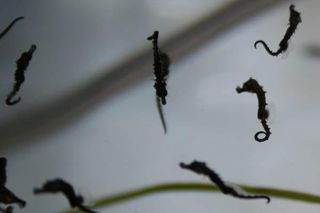
Live Seahorse Birth Caught on Tape
A teeny cavalry has burst onto the scene at the Tennessee Aquarium, where one of the resident lined seahorses recently gave birth to more than 100 babies.
Captured on video, the little seahorses can be seen popping out of a hole in their father's belly. (In the seahorse world, it is the males who carry the young and give birth.)
Carol Haley, the aquarium's assistant curator of fishes, captured the speedy delivery on video with her cell phone in the last week of January.
"There was a male that was starting his abdominal crunches that's exactly what it looks like," Haley said. "He was either going into convulsions or getting ready to have his babies."
Although lined seahorses, a particular species of seahorse, produce offspring at the Tennessee Aquarium every few weeks, it's hard to predict the event's exact time. Haley said that in the 10 years the aquarium has kept seahorses, this is only the second birth she's ever seen.

"I've walked by a tank and there aren't any babies in there, and walked by 10 minutes later and it's full of babies," Haley told OurAmazingPlanet.
As the video shows, lined seahorses give birth in just a matter of moments. Haley said the process is almost more akin to hatching. Females lay eggs inside a male's pouch, where the eggs are fertilized, and, two to four weeks later, the fully-formed young make their dramatic exit.
Sign up for the Live Science daily newsletter now
Get the world’s most fascinating discoveries delivered straight to your inbox.
The aquarium's newest brood of little seahorses is doing well, and another birth on Saturday (Jan. 29) has added to their number. Although only about 5 percent of the juveniles usually live to adulthood, that's a far higher survival rate than in the wild. With such an abundance of babies, the aquarium is planning to send some of the seahorses to other aquariums once they're big enough to travel.
The newly-hatched young are each a mere centimeter long (that's less than half an inch). Fully grown lined seahorses are usually between 5 and 6 inches (13 and 15 cm) long.
Below, watch a higher-resolution video of a Hippocampus kuda, or common seahorse a species found in the warmer waters of the Pacific Ocean giving birth at the London Zoo's aquarium.
{youtube MsHCqrrU-Gk}
Lined seahorses are native to the coastal waters of North America's eastern seaboard, stretching from Nova Scotia down to the warmer seas of the Gulf of Mexico and the Caribbean.
Sluggish swimmers, the little fishes rely on their mottled coloring a range of brown, rust, gray, orange and black for camouflage and the protection it brings.
All seahorse species are listed as vulnerable, according to the International Union for the Conservation of Nature, the organization that assesses the status of animal populations around the globe.
Some of the worldwide decline of seahorses has been linked to their use in traditional Chinese medicine.
Reach Andrea Mustain at amustain@techmedianetwork.com. Follow her on Twitter @AndreaMustain.
